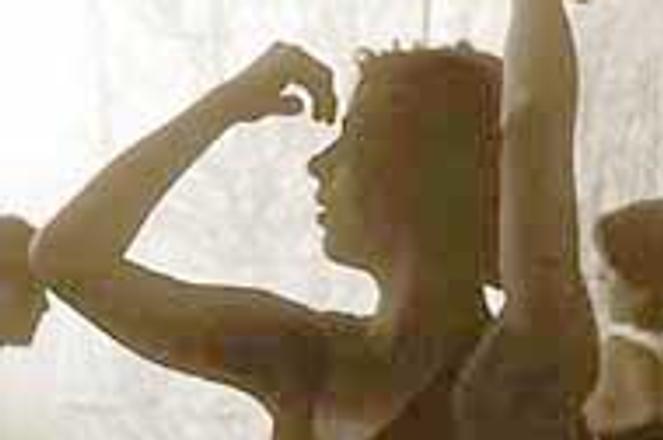Andrea Gašpáriková, a Centre for Movement Culture instructor, foreground, is one of the founders of the dance centre.photo: Courtesy Centrum pohybovej kultúry
FEEL the ground under your bare feet. As the music continues, move your head slowly from left to right, then your neck and whole body. Then follow the movement of your arm and feel the air around you.
The music dramatically changes after the first half hour and sensual John Lee Hooker-style tunes replace the rhythm and sound of drums.
The Capoeira is about to begin.
Capoeira is the rhythm of an old martial art, originating from the time of the Portuguese enslavement of Brazil, transformed into an accelerated and hectic dance rhythm.
"It is a development of our natural movements, and we try to load our bodies with strong energy," says Ján Gonščák, a 26-year-old teacher of Capoeira. "We have lost a contact with the ground, every fall is socially perceived as something bad and terribly insulting, we tend to forget that gravity, which is the cause of falling, is something so natural. We are trying to teach how to feel the earth and how to perceive space. Everything is pure rhythm."
Capoeira is not the only technique practised at the Centre of Movement Culture, which opened in 1998 after Ján, now a student at Bratislava's Music Academy (AMU) came back from France where he had studied kinetic theatre.
Feeling the bodies of others.photo: Courtesy Centrum pohybovej kultúry
The Centre is situated in a renovated building opposite the Petržalka railway station.
Together with his colleague Andrea Gašpáriková and guest lecturers, Ján holds various classes, from traditional aerobics and hip-hop to Jazz-Flamenco, so-called contemporary techniques and creative movement. For them, dance is the essence of life.
"People come here very often and ask suspiciously what we are doing. The problem is that they've never had a chance to see something different. Their culture neglects the body - after work many of them stay at home and watch TV. Also, many of them spend their working days in front of their PCs and live a virtual life. The techniques we develop here can be helpful in many ways, especially in improving physical and mental health."
Dance is a way of developing a sense of our physical body, says Ján. "People don't need any special talent to do this, they just need sensibility, and that sensibility can be developed. Since our childhood we have all been exposed to a system of education that criticises us for everything we don't possess. If somebody tells you that you don't have a talent for dancing, you will accept that as a fact and be persuaded of it all your life. But our digestive tracts and hearts have their own rhythm, and we have to follow it. We have to learn how to communicate with our bodies."
The basic philosophy of capoeira also draws on yoga. "Being laymen we don't try to get into the complicated system of thought behind yoga, we just use what it offers to us - a principle based on accepting ourselves at different levels of life with the possibility of development rather than competition. Yoga is against the prejudice that if we are missing one finger, then we are not able to work as machine operators. People with different problems come here. And for them dance is therapy. It helps people who have some bodily deformations, and those with a wide scope of psychological problems, such as inner uncertainty, a lack of self-worth and difficulty making social contacts.
"Originating as a martial art in the fields of Brazil, enriched later with acrobatic elements, Capoeira is a game, and transformed into dance it teaches us how to obtain control over our bodies, to feel the energy of others and to cope with a lack of confidence. For younger people who are still searching for themselves we recommend aerobics and hip-hop, but Capoeira and contemporary techniques are for older generations who are already aware of their own bodies, who want to feel the energy of others and who want to do something creative."
Ján Gonščák says that dancing can heal bodily and mental distress.photo: Courtesy Centrum pohybovej kultúry
In a dressing room several dancers wait for the next class to begin, while others prepare to go home. "I came because I wanted to dance and to get in shape. But I've found that dancing and moving give you a different feeling about people. It's all about tolerance," said Elena Kminiaková, 25.
Where:
Centrum pohybovej kultúry, Údernícka 5,
851 02 Bratislava,
bus stop ŽST Petržalka, bus lines 90, 82
Open:
Mon-Wed-Fri 7:00-20:40,
Tue-Thu 15:10-22:50,
Sat-Sun 17:00-22:10
Price:
Sk80-120 (per lesson),
monthly pre-paid possible
Tel:
0903/256-335, 0903/177-281
Tel/Fax:
02/5273-3064
Web site:
http://www.moving-studio.sk/
E-mail: hbat@moving-studio.sk


